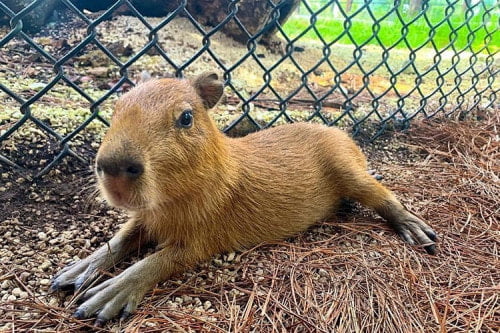Description
The Amazing World of Capybaras: Everything You Need to Know
If you’re looking for a fascinating and unusual animal to learn about, look no further than the capybara. These large, semi-aquatic rodents are native to South America and are the largest rodents in the world. In this article, we’ll explore everything you need to know about capybaras, from their physical characteristics to their behavior, diet, and more.
Physical Characteristics
Capybaras are easily recognized by their large size and distinctive appearance. They can grow up to 4 feet (1.2 meters) long and weigh up to 140 pounds (64 kilograms), making them much larger than other rodents like mice and rats. They have short, dark brown fur that’s thick and bristly, and they’re built for swimming with webbed feet and a streamlined body.
One interesting thing about capybaras is that they have eyes, ears, and nostrils that are all located on the top of their head. This allows them to keep most of their body submerged in water while still being able to see, hear, and smell everything around them.
Habitat and Distribution
Capybaras are native to South America and can be found in a variety of habitats, including rainforests, grasslands, and wetlands. They are social animals and live in groups of up to 20 individuals, usually near water sources like rivers, lakes, and swamps.
Diet
Capybaras are herbivores and primarily eat grasses, aquatic plants, and fruit. They have large front teeth that are perfect for cutting through tough vegetation, and they also have specialized digestive systems that allow them to extract nutrients from tough, fibrous plants.
Behavior
As mentioned earlier, capybaras are social animals that live in groups. They are also very vocal and communicate with a variety of sounds, including barks, whistles, and purrs. In addition, they are excellent swimmers and can hold their breath for up to 5 minutes underwater.
Capybaras are also known for their unique relationship with other animals. They have been observed allowing birds to sit on their backs and eat insects that the capybaras stir up while grazing. This mutually beneficial relationship is just one example of the fascinating behavior of these animals.
Keeping Capybaras as Pets
Capybaras are sometimes kept as pets, but they are not a good choice for everyone. They require a lot of space, water, and specialized care, and they can be quite expensive to maintain. In addition, they are social animals that require the company of other capybaras or similarly sized animals.
If you’re interested in owning a capybara, be sure to do your research and make sure you can provide the necessary care and environment for these unique animals.
capybaras are fascinating animals with a lot of unique characteristics and behaviors. Whether you’re interested in learning about them as a curious observer or considering owning one as a pet, it’s important to understand the special needs and requirements of these amazing creatures. With proper care and attention, capybaras can be a rewarding and enriching addition to any animal lover’s life.





